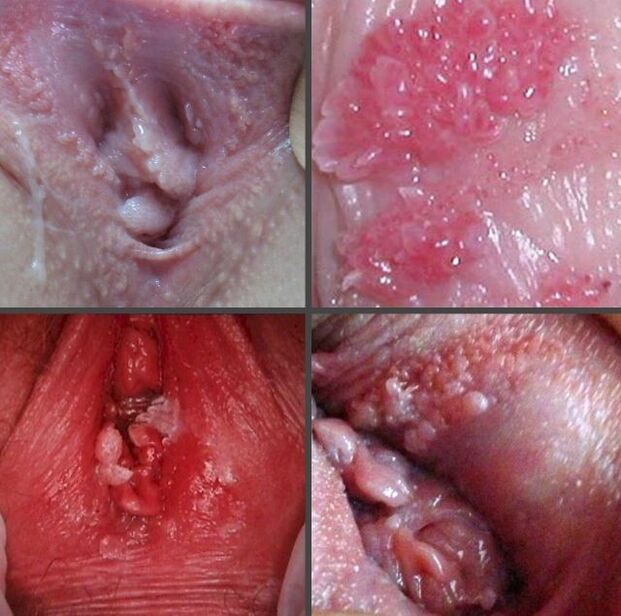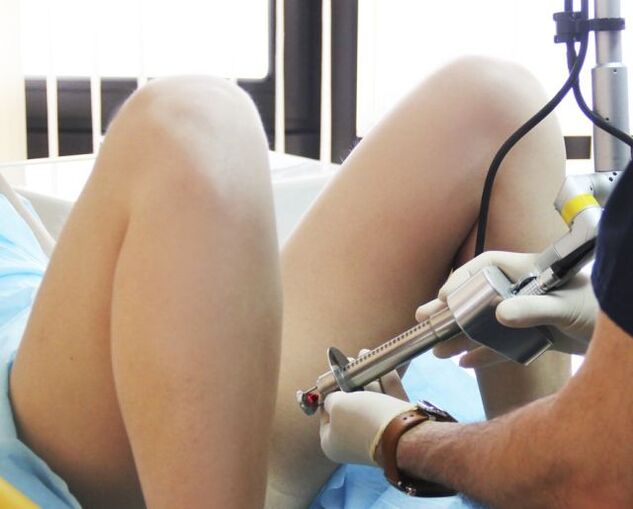
Papillomas in the vagina are benign small formations located in the perineal area and on the mucosa of the vaginal walls. The cause of the appearance of such lumps, which are called warts in medicine, is human papillomavirus infection. The treatment of this type of papilloma has its own characteristics, as most devices intended for external use and most of the alternative methods cannot be used on the mucosa.
What do papillomas in the vagina look like?

The woman herself can hardly imagine what papillomas look like inside the vagina, usually the disease is accidentally diagnosed during a gynecological examination.
Sometimes, when the growth of the labia and the entrance to the vagina is localized, a woman may grope on them while washing or washing. Small warts do not manifest in any way and do not cause discomfort.
Warts differ in appearance: they may be pointed or resemble a rooster comb. There are single papillomas or large combined growth accumulations. Pointed papillomas on the legs resemble white cilia that can explode, leaving a small amount of unpleasant-smelling fluid.
Note! In the early stages of the disease, papillomas in the vagina are tiny spider veins that are difficult to spot even in a gynecological examination.
Medically, vaginal papillomas fall into two types:
- Exophytic. . . These are benign formations that protrude above the surface of the mucosa and are called prickly.
- Endophytic. . . Such warts grow inside the epithelium, are flat in appearance, and are not immediately noticeable. During the test, they are detected as small seals on the mucous membranes. These vaginal papillomas are the most dangerous because they can progress to malignancies.
The color of genital warts can be light pink or dark brown. As the disease develops, the formations grow and merge into growths that resemble cauliflower inflorescence in appearance. Large papillomas are easily identified visually and, in addition, cause significant discomfort to a woman, especially during sexual intercourse.
When papillomas appear in the vagina, a woman may not feel the symptoms of the disease for a long time. Discomfort increases with increasing growth. They may be injured during intercourse, in some cases mild bleeding and pain are possible. This type of discomfort usually causes a woman to see a gynecologist who diagnoses her.
Important! The disease is almost impossible to detect in the initial stages because HPV has a long incubation period. The first symptoms may appear only 2-3 months after infection. The sooner the virus manifests, the better the prognosis for complete recovery.
Causes of papillomas in the vagina
.jpg)
The cause and growth of papillomas in the vagina is caused by papillomavirus infection. Most often, such localization of genital warts is characteristic of women who neglect contraceptive contraceptives. A man may not be aware that he is a carrier of the virus, he often has no symptoms of the disease, but his partner is beginning to manifest itself quite clearly.
It should be said that papillomavirus can also be infected during protected sexual intercourse, as the carrier of the infection may be present on the skin and hair in the male external genital area. In case of infection, even minimal contact with the virus carrier is sufficient. Infection is particularly easy to occur if the body’s defenses are weakened in a woman.
Knocking down the pathogenic microflora on the mucous membranes of the female genitals does not necessarily lead to the development of the disease. Papillomas in the vagina begin to grow actively due to a number of negative factors:
- systemic diseases of various etiologies that negatively affect immunity (infectious diseases, pathologies of the endocrine system, problems of the urogenital system, and others);
- have undergone surgical procedures, especially in connection with general anesthesia;
- excessive alcohol consumption, smoking;
- drug addiction, and immunity is markedly weakened by light drugs and smoking blends;
- sex life, frequent exchange of sexual partners;
- constant nervous tension, stress, lack of sleep;
- early pregnancy and adolescent birth;
- inflammatory processes in the body, chronic sexually transmitted diseases;
- excessive physical activity, violation of the work and rest system;
- unbalanced diet, loss of appetite, lack of vitamins and minerals in the body.
It can also provoke papillomas in the vaginaexternal causessuch as poor environmental conditions or poor hygiene.
It can be a catalyst for the activation of papillomavirus and the appearance of genital warts on the mucous membranes of the genitals.the presence of HIV in the body. . .
Important! The absence of papillomas in the vagina after sexual contact with an infected man does not mean that the woman is not infected with HPV. With strong immunity, the disease cannot manifest in any way, but the woman herself becomes a potential source of danger.
Treatment of papillomas in the vagina
Vaginal papillomas are only a manifestation of the human papillomavirus, so treatment will be effective if a number of measures are taken. First, antiviral drug therapy is performed, which includes drugs for internal use, including injectable drugs, and agents for topical exposure. Some effect is also given by prescriptions of traditional medicine, which can only be used in consultation with your doctor. Conventional devices for external use are also not always suitable for cauterizing vaginal papillomas, as they act too aggressively on such formations and can cause severe burns to the mucosa.
Medicines for the treatment of papillomas in the vagina
The choice of drugs to treat vaginal papillomas depends on the results of the test, which includes a number of mandatory diagnostic measures: gynecological examination with mirrors to detect the presence of genital warts, examination with a colposcope to see flat growth, analysis of human papillomavirus type.
Based on the results of the research and analysis, the physician should prescribe medications for internal and topical use. This complex contains antiviral agents, immune-boosting drugs, and agents for the direct control of vaginal papillomas. Of these drugs, the most effective can be distinguished:
- The latest means of strengthening the immune system, in the form of tablets, in a dose of 1 or 10 mg. The drug has no toxic effects. In addition to increasing immunity, the drug has an antitumor effect. Take 1 tablet daily before meals.
- Tablets made from plant materials with antiviral and bacteriostatic effects. In the treatment of papillomas in the vagina, 1 tablet is prescribed 3 times a day.
- It is one of the most advanced antiviral drugs that acts directly on the pathogenic microflora. Made in Israel. It also has an immunomodulatory effect. It is available as 500 mg tablets. Treatment usually lasts for 2 weeks, taking 2 tablets 3 times a day.
- The product is naturally based, a potent immunomodulator, and also has pronounced antiviral activity. They are used for topical exposure and are available in a variety of dosage forms, including vaginal suppositories.
If papillomas are found in the vagina, this disease can only be diagnosed with medication by the attending physician, as each medication has its own contraindications and side effects. In some cases, medication may be sufficient and the vaginal papillomas may disappear after one or more treatments.
Important! The treatment of papillomas in the vagina during pregnancy requires special care. Most popular antiviral medications should not be taken during pregnancy, so self-medication is not permitted during this period.
Hardware removal of papillomas in the vagina

Vaginal removal of papillomas is used by various hardware techniques in cases where medication has not produced the expected results. The choice of method is determined by the physician based on the tools available and the individual characteristics of the development of the disease.
Modern medicine offers the following methods:
- Cryodestruction. . . This is the removal of papillomas at low temperatures. It is a popular and well-proven method for removing formations on the skin and mucous membranes. The action is based on the ability of liquid nitrogen to destroy the structure of papillomas and stop the growth process. The latest devices are used in modern clinics. The procedure is affordable and popular for rapid healing, although it is accompanied by some inconvenience during cauterization. The cost of the procedure depends on the level of the clinic.
- Laser removal. . . It is the most modern but most expensive method of removing papillomas in the vagina. Its advantage is that it is able to get rid of genital warts with minimal discomfort in 1 session. As a result of the laser beam, the formation on the mucosa dries out immediately and disappears.
- Electrocoagulation. . . The way papillomas are removed in the vagina is based on the ability of the electric current to destroy the growth structure on the skin and mucous membranes and stop their growth.
- Removing radio waves. . . This is the least painful way to remove papillomas and is therefore especially popular. As a result of the radio waves, the DNA of the virus is destroyed and further proliferation of the pathogenic cells becomes impossible.
Hardware methods for removing papillomas in the vagina present some difficulties because it is impossible to accurately affect the growth in the depth of the vagina, so the procedure should only be performed by an experienced physician.
Folk remedies for vaginal papillomas

In general, doctors do not object to traditional methods of treating papillomas on the skin, but the formations on the mucous membranes require special care. This is especially true for papillomas at the entrance to the vagina and its walls. Such localization of growth precludes women from being able to act accurately on the surface of genital warts and there is a high risk of burning of surrounding tissues.
From traditional medicine, you can use sea buckthorn oil, which has a bactericidal effect, ammonia and tar soap.
It should be understood that alternative therapies are in addition to the main therapy as they cannot rid the woman of the cause of the appearance of genital warts. Human papillomavirus can only be released by long-term systemic treatment under the supervision of a qualified professional.
Important! The use of any prescription for traditional medicine requires a mandatory discussion with your doctor.
Prevention of the appearance of papillomas in the vagina

Prevention of vaginal papillomas is reduced by following these recommendations:
- you should not have questionable sex without a condom;
- if possible, inquire about the health status of the sexual partner;
- check personal hygiene carefully;
- avoid nervous and physical overload;
- follow a proper diet, eat more fruits and vegetables;
- consult a doctor if you have the first symptoms of the disease.
In summary, it must be said that HPV is a very common virus and not all patients have pronounced symptoms of infection. The appearance of papillomas in the vagina requires treatment at the earliest stage of the disease, in which case complex therapy may result in a good effect.















































































